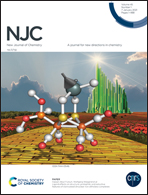rGO–diaminobutane surfaces with optimized N doping and hydrodynamics as dual proton–electron conductors and carbon photocatalysts
Abstract
The hybrids of reduced graphene oxide (rGO) and diaminoalkane (DAA) including rGO–DAP, rGO–DAB, and rGO–DAPN (DAP = 1,4-diaminopropane, DAB = 1,4-diaminobutane and DAPN = 1,4-diaminopantane) were synthesized by solventless vapor phase reduction of the respective GO-hybrids, namely, GO–DAP, GO–DAB, and GO–DAPN. Within this rGO–DAA series, the optimization of N-doping, electronic conductivity (EC), and water dynamics (evaluated by the measurement of the proton conductivity value) is observed in rGO–DAB. The EC of rGO–DAB is 1.72 μA V−1, which is higher than the EC of reported rGO–alkylamine (rGO–AA) hybrids. The PC of rGO–DAB is ≈10−3–10−4 S cm−1, which is slightly less than that of pristine GO. The extent of N doping at the graphitic carbon skeleton is 6.7%, which is higher than that of all the reported rGO–AA hybrids. The rGO–DAB could afford photocatalytic water splitting (WS) and dye degradation (DD). The efficiency toward WS is 18.48 μmol h−1 g−1, whereas the efficiency toward the degradation of methylene blue (MB) revealed a kLH value of 0.015 min−1. Both these values are higher than those of the reported rGO–AA hybrids. The DAP precursor contributes to N doping in rGO. The hybrids thus function as bandgap semiconductors and aid light-harvesting photocatalysis. The high EC and super-fast hydrodynamics supported the electron mediation and propagation of water/MB molecules to the N-doped center during reactions. Therefore, in addition to the generation of electron/hole pairs, the materials can trigger the mechanistic pathway of photocatalysis. These findings suggest that the catalytic activity of rGO-based materials can be improved not only by engineering the surface and bandgap property but also by improving the electronic conductivity and hydrodynamics within the staked layers of rGO.



 Please wait while we load your content...
Please wait while we load your content...